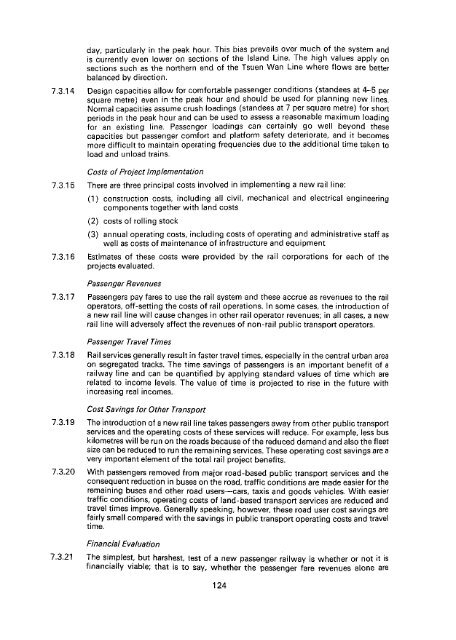Untitled - HKU Libraries - The University of Hong Kong
Untitled - HKU Libraries - The University of Hong Kong
Untitled - HKU Libraries - The University of Hong Kong
- No tags were found...
You also want an ePaper? Increase the reach of your titles
YUMPU automatically turns print PDFs into web optimized ePapers that Google loves.
day, particularly in the peak hour. This bias prevails over much <strong>of</strong> the system andis currently even lower on sections <strong>of</strong> the Island Line. <strong>The</strong> high values apply onsections such as the northern end <strong>of</strong> the Tsuen Wan Line where flows are betterbalanced by direction.7,3.14 Design capacities allow for comfortable passenger conditions (standees at 4-5 persquare metre) even in the peak hour and should be used for planning new lines.Normal capacities assume crush loadings (standees at 7 per square metre) for shortperiods in the peak hour and can be used to assess a reasonable maximum loadingfor an existing line. Passenger loadings can certainly go well beyond thesecapacities but passenger comfort and piatform safety deteriorate, and it becomesmore difficult to maintain operating frequencies due to the additional time taken toload and unload trains.Costs <strong>of</strong> Project Implementation7.3.1 5 <strong>The</strong>re are three principal costs involved in implementing a new rail line:(1) construction costs, including ail civil, mechanical and electrical engineeringcomponents together with land costs(2) costs <strong>of</strong> rolling stock(3) annual operating costs, including costs <strong>of</strong> operating and administrative staff aswell as costs <strong>of</strong> maintenance <strong>of</strong> infrastructure and equipment7.3.16 Estimates <strong>of</strong> these costs were provided by the rail corporations for each <strong>of</strong> theprojects evaluated.Passenger Revenues7.3.17 Passengers pay fares to use the rail system and these accrue as revenues to the railoperators, <strong>of</strong>f-setting the costs <strong>of</strong> rail operations. In some cases, the introduction <strong>of</strong>a new rail line will cause changes in other rail operator revenues; in all cases, a newrail line will adversely affect the revenues <strong>of</strong> non-rail public transport operators.Passenger Travel Times7.3.18 Rail services generally result in faster travel times, especially in the central urban areaon segregated tracks. <strong>The</strong> time savings <strong>of</strong> passengers is an important benefit <strong>of</strong> arailway line and can be quantified by applying standard values <strong>of</strong> time which arerelated to income levels. <strong>The</strong> value <strong>of</strong> time is projected to rise in the future withincreasing real incomes.Cost Savings for Other Transport7.3.19 <strong>The</strong> introduction <strong>of</strong> a new rail line takes passengers away from other public transportservices and the operating costs <strong>of</strong> these services will reduce. For example, less buskilometres will be run on the roads because <strong>of</strong> the reduced demand and also the fleetsize can be reduced to run the remaining services. <strong>The</strong>se operating cost savings are avery important element <strong>of</strong> the total rail project benefits.7.3.20 With passengers removed from major road-based public transport services and theconsequent reduction in buses on the road, traffic conditions are made easier for theremaining buses and other road users—cars, taxis and goods vehicles. With easiertraffic conditions, operating costs <strong>of</strong> land-based transport services are reduced andtravel times improve. Generally speaking, however, these road user cost savings arefairly small compared with the savings in public transport operating costs and traveltime.Financial Evaluation7.3.21 <strong>The</strong> simplest but harshest test <strong>of</strong> a .new passenger railway is whether or not it isfinancially viable; that is to say, whether the passenger fare revenues alone are124
















